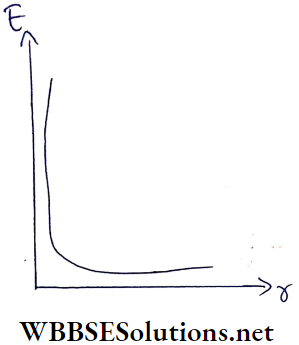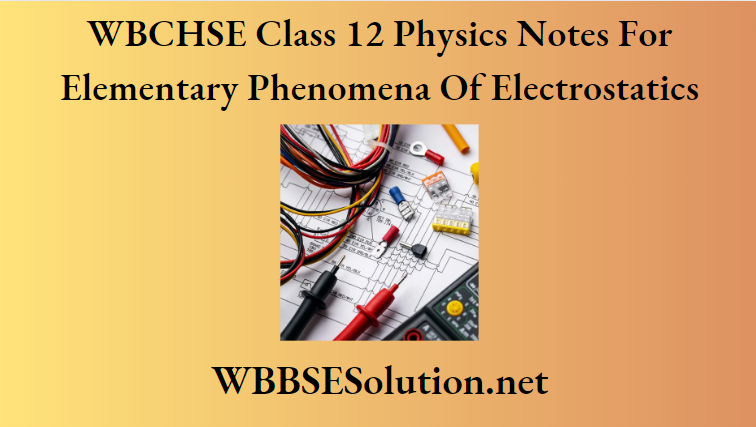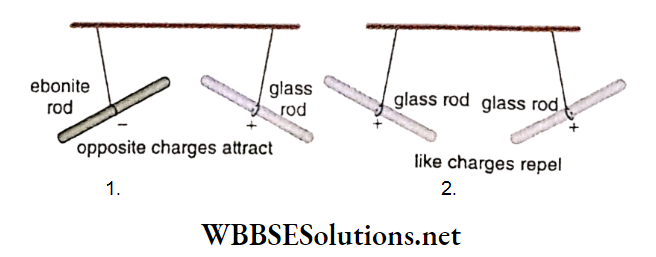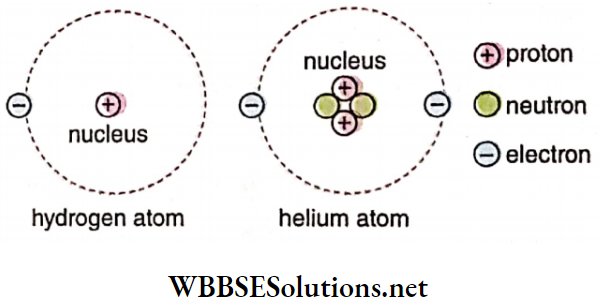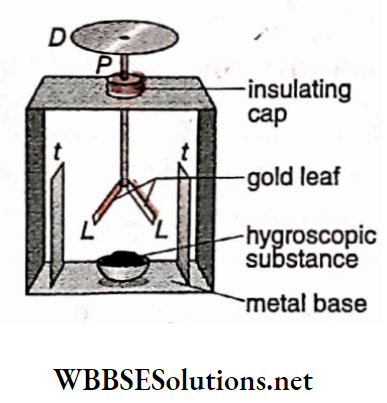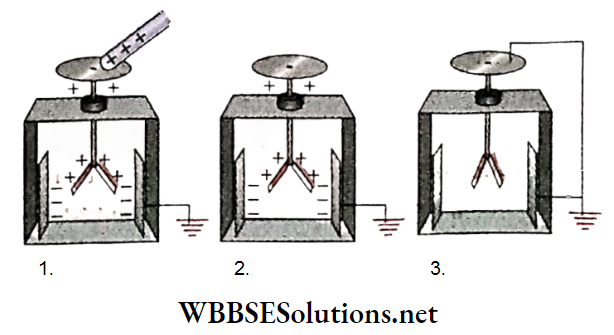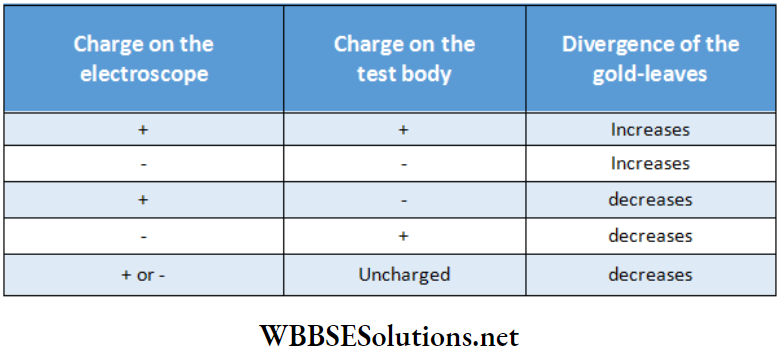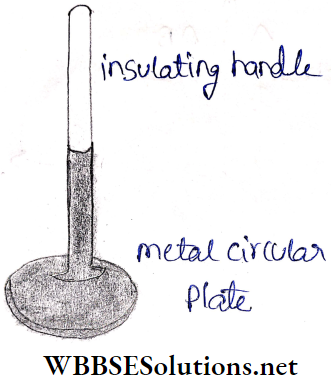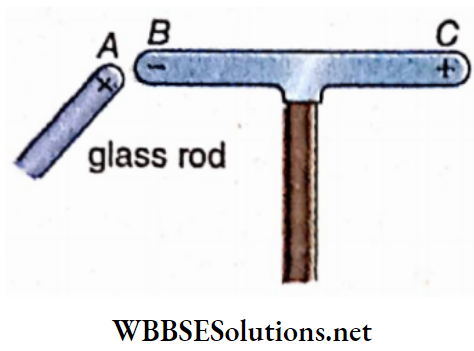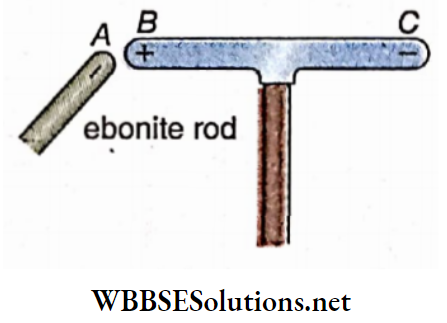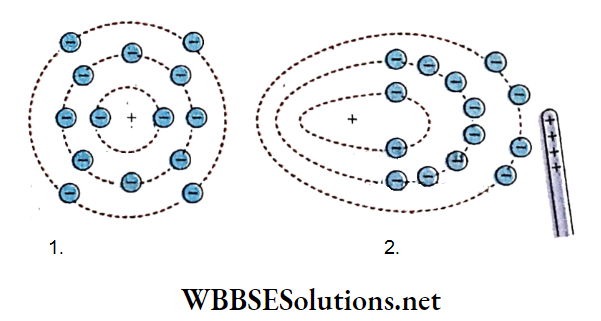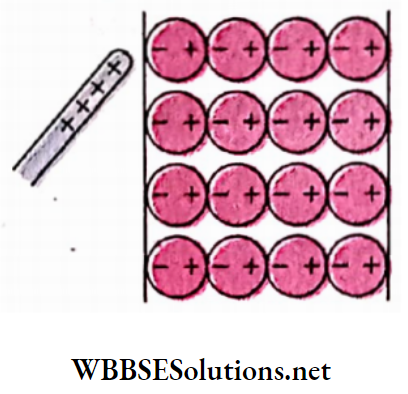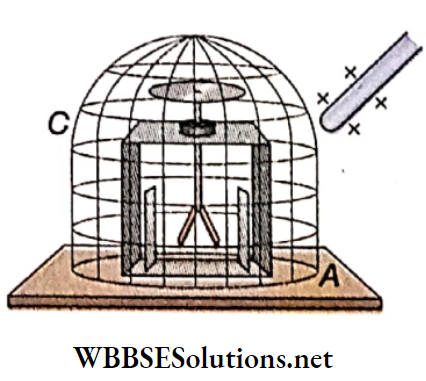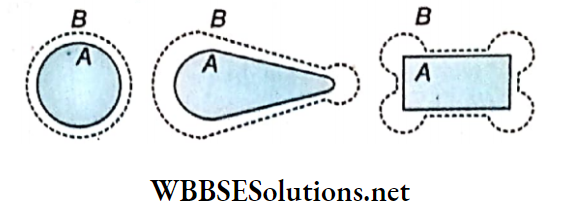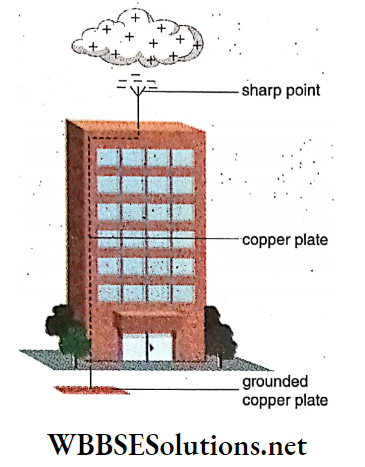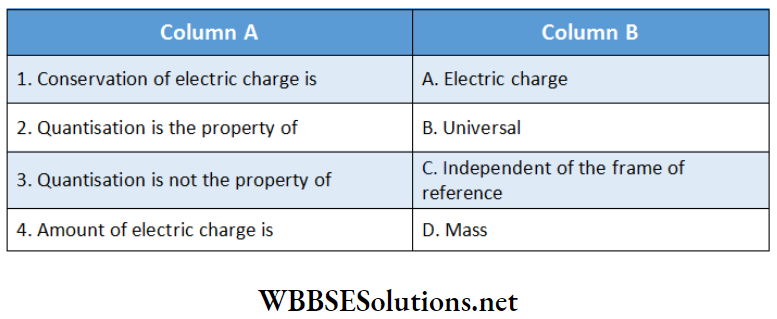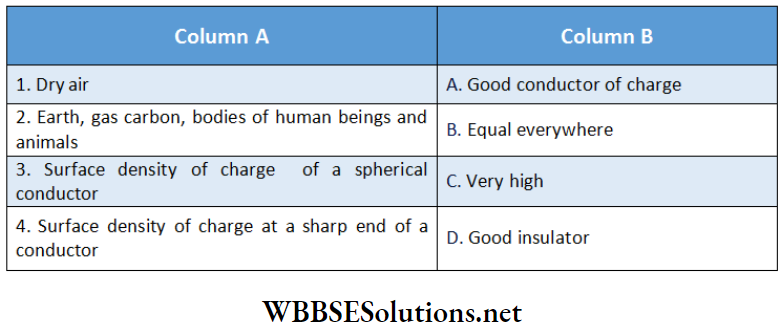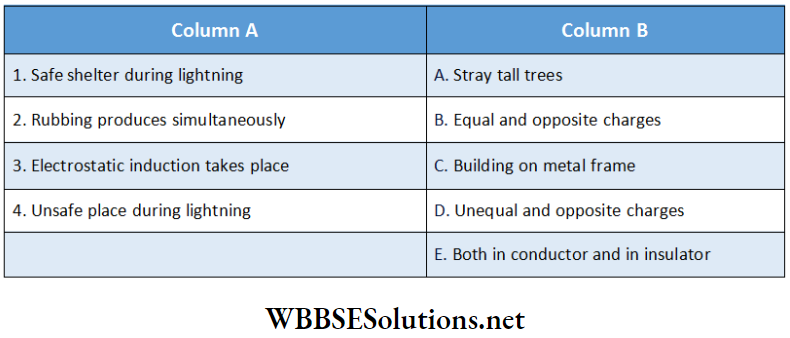Unit 1 Electrostatics Chapter 2 Electric Field Short Question And Answers
Question 1. An electrostatic field line is a continuous curve. That is, a field line cannot have sudden breaks. Why not?
Answer:
An electrostatic field line is a continuous curve. That is, a field line cannot have sudden breaks.
The tangent drawn at any point of an electrostatic field line indicates the direction of the field at that point Electrostatic field being continuous the field lines (or the lines of force) cannot have any sudden break.
Question 2. Check that the ratio ke²/Gmemp is dimensionless. From the table of physical constants, determine the value of this ratio. What does the ratio signify?
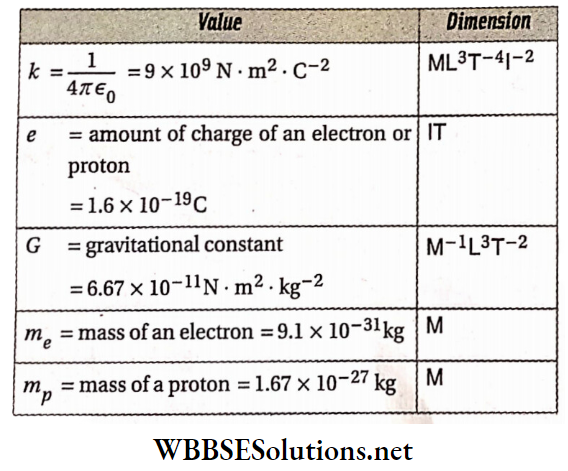
Answer:
Dimension of
⇒ \(\left[\frac{k e^2}{G m_e m_p}\right]=\frac{\mathrm{ML}^3 \mathrm{~T}^{-4} \mathrm{I}^{-2} \mathrm{I}^2 \mathrm{~T}^2}{\mathrm{M}^{-1} \mathrm{~L}^3 \mathrm{~T}^{-2} \cdot \mathrm{M} \cdot \mathrm{M}}=\mathrm{M}^0 \mathrm{~L}^0 \mathrm{~T}^0\)
∴ The ratio is dimensionless
⇒ \(\frac{k e^2}{G m_e m_p}=\frac{\left(9 \times 10^9\right) \times\left(1.6 \times 10^{-19}\right)^2}{\left(6.67 \times 10^{-11}\right) \times\left(9.1 \times 10^{-31}\right)}\)
= 2.27 X 1031
The ratio can be written as
⇒ \(=\frac{k e^2}{r^2}: \frac{G m_e m_p}{r^2}\)
⇒ \(\frac{electrostatic force of attraction between a proton and an electron}{gravitational force of attraction between a proton and an electron}\)
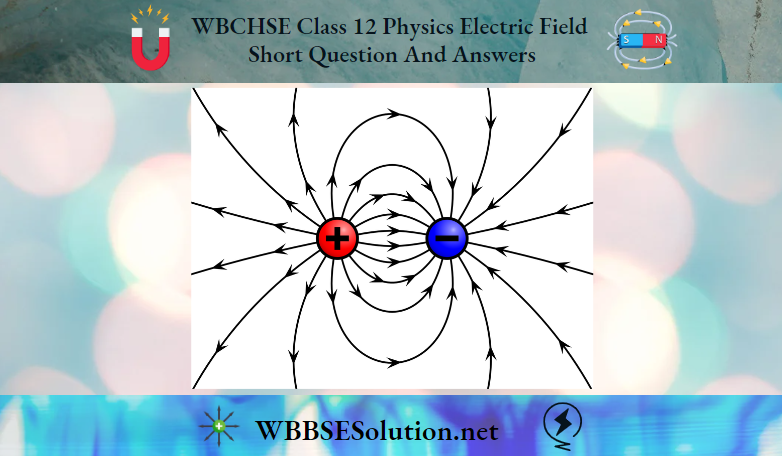
Question 3. The track of three charged particles in a uniform electrostatic field, Give the signs of the three charges. Which particle has the highest target mass ratio?
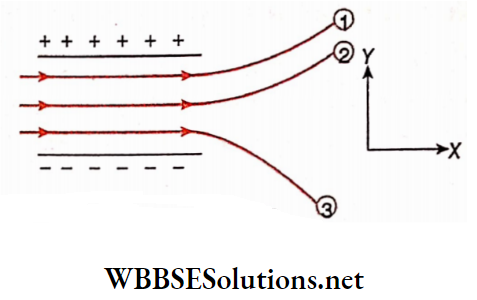
Answer:
The track of three charged particles in a uniform electrostatic field, Give the signs of the three charges.
Particles 1 and 2 are negative charges as these are attracted towards the positive plate while particle 3 is positively charged. The \(\frac{e}{m}\) ratio is highest for particle 3 as its deflection is maximum.
Question 4. Careful measurement of the electric field at the surface of a black box indicates that the net outward flux through the surface of the box is 8.0 x 103N m2.C-1.
- What is the net charge inside the box?
- If the net outward flux through the surface of the box were zero, could you conclude that there were no charges inside the box? Why or why not?
Answer:
1. Flux = \(\frac{q}{\epsilon_0}\)
∴ q = eee0 X flux = 8.854 x 10-12 x 8 x 103 C
= 0.07μC
2. It cannot be said that the box has no charge inside it because if it contained an equal amount of positive and negative charges, the flux would have been zero. It can only be said that the net charge inside the box is zero.
Question 5. A point charge of 10μC is placed at a distance 5 cm directly above the center of a square of side 10 cm. What is the magnitude of the electric flux through the square?
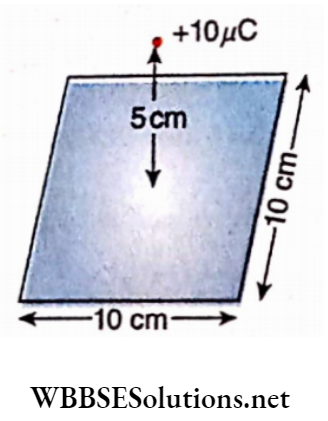
Answer:
A point charge of 10μC is placed at a distance 5 cm directly above the center of a square of side 10 cm.
Let the plane ABCD be one of the sides of a cube of side 10 cm. The point P is situated at the center of the cube.
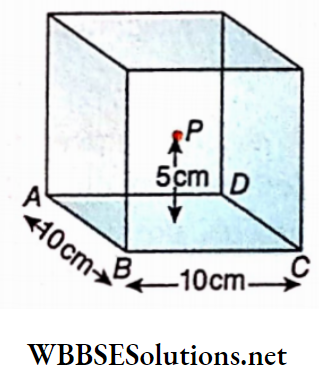
∴ Flux passing through ABCD
⇒ \(\frac{1}{6} \frac{q}{\epsilon_0}=\frac{1}{6} \times \frac{10 \times 10^{-6}}{8.85 \times 10^{-12}} \mathrm{~N} \cdot \mathrm{m}^2 \cdot \mathrm{C}^{-1}\)
= 1.88 X 105 N.m2.C-1
Question 6. A conducting sphere of radius 10 cm has an unknown charge. If the electric field 20 cm from the center of the sphere is 1.5 x 103 N.C-1 and points radially inward, what is the net charge on the sphere?
Answer:
A conducting sphere of radius 10 cm has an unknown charge. If the electric field 20 cm from the center of the sphere is 1.5 x 103 N.C-1 and points radially inward
Electric field,
⇒ \(E=\frac{1}{4 \pi \epsilon_0} \frac{q}{r^2}\)
∴ \(q=\frac{E r^2}{\left(\frac{1}{4 \pi \epsilon_0}\right)}=\frac{1.5 \times 10^3 \times(0.2)^2}{9 \times 10^9} \mathrm{C}\)
= 6.67nC
Question 7. Two large, thin metal plates are parallel and close to each other. On their inner faces, the plates have surface charge densities of opposite signs and of magnitude 17.0 x 10-22C.m-2. What is the electric field
- In the outer region of the first plate?
- In the outer region of the second plate?
- Between the plates?
Answer:
Two large, thin metal plates are parallel and close to each other. On their inner faces, the plates have surface charge densities of opposite signs and of magnitude 17.0 x 10-22C.m-2.
1. \(E_1=-\frac{\sigma_A+\sigma_B}{2 \epsilon_0}=-\frac{\sigma_A-\sigma_A}{2 \epsilon_0}=0\) [∵ \(\sigma_A=-\sigma_B=17.0 \times 10^{-22} \mathrm{C} \cdot \mathrm{m}^{-2}\)]
2. Similarly, E2 = 0
3. \(E_3=\frac{\sigma_A-\sigma_B}{2 \epsilon_0}\)
= \(\frac{2 \sigma_A}{2 \epsilon_0}\)
= \(\frac{\sigma_A}{\epsilon_0}\)
= \(\frac{17.0 \times 10^{-22}}{8.854 \times 10^{-12}}\)
= 1.92 X 10-10 N C-1
Question 8. In a certain region of space, the electric field is along the z direction throughout. The magnitude of the electric field is, however, not constant but increases uniformly along the positive z -direction, at the rate of 105 N.C-1 per meter. What are the force and torque experienced by a system having a total dipole moment equal to 10-7 C m in the negative z-direction?
Answer:
In a certain region of space, the electric field is along the z direction throughout. The magnitude of the electric field is, however, not constant but increases uniformly along the positive z -direction, at the rate of 105 N.C-1 per meter.
Let the dipole be along z -direction
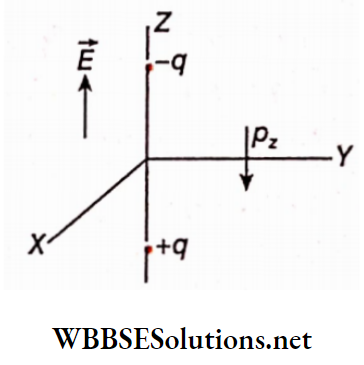
∴ Dipole moment, pz = -10-7 C.m
⇒ \(\frac{\partial E}{\partial z}=10^5 \mathrm{~N} \cdot \mathrm{C}^{-1} \cdot \mathrm{m}^{-1}\)
∴ Net force = \(p_x \frac{\partial E}{\partial x}+p_y \frac{\partial E}{\partial y}+p_z \frac{\partial E}{\partial z}\)
= 0 + 0-10-7 X 105 N
= -10-2 N
Torque = pEsinθ = pEsin80° = 0
Question 9.
- A conductor A with a cavity is given a charge Q. Show that the entire charge must appear on the outer surface of the conductor.
- Another conductor B with charge q is inserted into the cavity keeping B insulated from A. Show that the total charge on the outside die surface of A is (Q + q).
- A sensitive instrument is to be shielded from the strong electrostatic fields in its environment. Suggest a possible way.
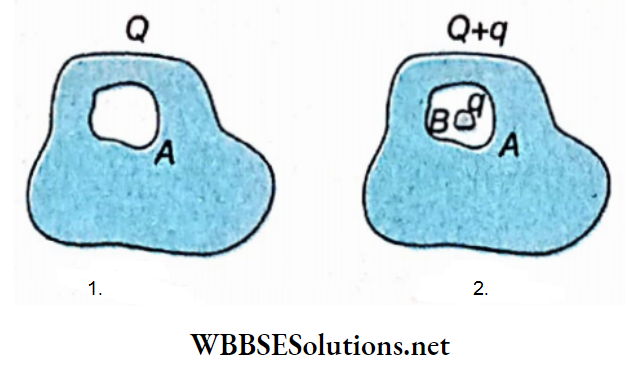
Answer:
1. The charge will reside on the outer surface of the conductor.
2. Charge q inside the cavity would induce a charge -q on the inner side of the cavity and a charge + q would appear on the outer surface making the total charge on this surface equal to (Q + q).
3. The instrument has to be kept inside a closed metallic shell to shield it from the strong electric fields in its environment.
Question 10. A hollow charged conductor has a tiny hole cut into its surface. Show that the electric field in the hole is \(\frac{\sigma}{\epsilon_0} \hat{n}\) where h is the unit vector in the outward direction, after is the surface density of charge near the hole.
Answer:
A hollow charged conductor has a tiny hole cut into its surface.
Suppose the hole has been plugged. Then the field inside the conductor is zero and outside it is \(\frac{\sigma}{\epsilon_0} \hat{n}\). This field is essential the sum of two fields.
One due to the plugged hole and the other due to the rest of the conductor. Inside the conductor, these two forces are equal and opposite and the resultant is zero.
But on the outer surface, these two forces are equal and act in the same direction.
Since the resultant is \(\frac{\sigma}{\epsilon_0} \hat{n}\) then each of 0 these forces is equal to \(\frac{\sigma}{2\epsilon_0} \hat{n}\).
Thus the electric field in the hole is equal to \(\frac{\sigma}{\epsilon_0} \hat{n}\).
Question 11. It is now believed that protons and neutrons (which constitute nuclei of ordinary matter) are themselves built out of more elementary units called quarks. A proton and a neutron consist of three quarks each. Two types of quarks, the so-called ‘up’ quark (denoted by’ u ‘) ofcharge + \(\frac{2}{3}\)e and the ‘down’ quark (denoted by ‘ d ‘) of charge –\(\frac{1}{3}\)e, together with electrons build up ordinary matter. Suggest a possible quark composition of a proton and a neutron
Answer:
It is now believed that protons and neutrons (which constitute nuclei of ordinary matter) are themselves built out of more elementary units called quarks. A proton and a neutron consist of three quarks each. Two types of quarks, the so-called ‘up’ quark (denoted by’ u ‘) ofcharge + \(\frac{2}{3}\)e and the ‘down’ quark (denoted by ‘ d ‘) of charge –\(\frac{1}{3}\)e, together with electrons build up ordinary matter.
The charge of a proton +e.
A proton can be made up of 2u ‘s and Id because In dial case the total charge = \(\frac{2 e}{3}+\frac{2 e}{3}-\frac{e}{3}=e\)
∴ A proton can be composed as used.
A neutron has no charge. It can be made up of 2d ‘s and I u because In that case the total charge = \(\frac{2}{3} e-\frac{1}{3} e-\frac{1}{3} e=0\)
∴ A neutron can be composed as udd.
Question 12.
- Consider an arbitrary electrostatic field configuration. A small test charge is placed at a null point (i.e, where \(\vec{E}\) = 0) of the configuration. Show that the equilibrium of the test charge Is necessarily unstable.
- Verify this result for the simple configuration of two charges of the same magnitude and sign placed at a certain distance apart.
Answer:
1. Let us assume the free charge to remain in stable equilibrium. Under this condition, the test charge would return to its original position of neutral point when deflected slightly in any direction. This implies that all the field lines near the neutral point are directed towards it.
This proves the existence of inward-bound electric flux associated with the imaginary Gaussian surface surrounding the point But according to Gauss’ theorem, the flux associated with a closed surface in the absence of any enclosed charge is zero. Hence our assumption was not correct, i.e., the free charge should remain in unstable equilibrium.
2. In this case the neutral point is the mid-point of the line joining the two charges. If the free charge is moved slightly from its position along the line connecting the charges, the restoring force will bring the charge back to its original position.
But if it is moved along a direction normal to the line, then it will move further due to the effect of the resultant force. Thus the free charge is not in stable equilibrium.
Question 13. An infinite line charge produces a field of 9 x 104 N.C-1 at a distance of 2 cm. Calculate the linear charge density.
Answer:
An infinite line charge produces a field of 9 x 104 N.C-1 at a distance of 2 cm.
The field at a distance r from a system with linear charge density is given by
⇒ \(E=\frac{1}{2 \pi \epsilon_0} \cdot \frac{\lambda}{r} \quad \text { or, } \lambda=4 \pi \epsilon_0 \frac{E r}{2}\)
∴ \(\lambda=\frac{1}{9 \times 10^9} \times \frac{9 \times 10^4 \times 0.02}{2}\)
= 10-7 C.m-1
Question 14. A spherical conductor of radius 12 cm has a charge of 1.6 x 10-7C distributed uniformly on its surface. What is the electric field?
- Inside the sphere?
- Just outside the sphere?
- At a point 18 cm from the center of the sphere?
Answer:
1. The electric field inside the conductor is zero because the charge resides on the outer surface of the conductor.
2. Electric field just outside the sphere
⇒ \(E=\frac{1}{4 \pi \epsilon_0} \cdot \frac{q}{R^2}=9 \times 10^9 \times \frac{1.6 \times 10^{-7}}{(0.12)^2}\)
= 105 N.C-1
3. Electric field at a distance 18 cm from the centre,
⇒ \(E^{\prime}=\frac{1}{4 \pi \epsilon_0} \frac{q}{r^2}=9 \times 10^9 \times \frac{1.6 \times 10^{-7}}{(0.18)^2}\)
= 4.44 x 104 N.C-1
Question 15. Two charged conducting spheres of radii a and b are connected to each other by a wire. What is the ratio of electric field at the surfaces of the two spheres?
Answer:
Two charged conducting spheres of radii a and b are connected to each other by a wire.
When two conducting spheres are connected to each other by a wire, a transfer of charge will take place until the two spheres attain the same potential.
i.e., V1 = V2
or, E1a = E2b
∴ \(\frac{E_1}{E_2}=\frac{b}{a}\)
Question 16. Two large conducting spheres carrying charges Q1 and Q2 were brought close to each other. Is the magnitude of the electrostatic force between them exactly given by \(Q_1 Q_2 / 4 \pi \epsilon_0 r^2\), where r is the distance between their centers?
Answer:
No, because Coulomb’s law is applicable only for point charges. For large conductors, if the distance between the conductors becomes very large, then only their size may be neglected. Further, the charges reside only on the surface of the conductor, so the charge distribution is not uniform.
Question 17. A small test charge is released at rest at a point in an electrostatic field configuration. Will it travel along the field line passing through that point?
Answer:
A small test charge is released at rest at a point in an electrostatic field configuration.
The electrostatic force acts along the field line. Hence the test charge will be accelerated along the field line passing through the point. Its velocity (i.e., the motion) will be along the same direction only if the field line is a straight line.
Question 18. Four point charges +q, + q, +q, and -q are placed at the four comers of a square, the length of each side of which is a . Find the magnitude of the intensity of the electric field at the center of the square.
Answer:
Four point charges +q, + q, +q, and -q are placed at the four comers of a square, the length of each side of which is a
The point of intersection O of the diagonals is equidistant from four charges.
∴ \(O A=O B=O C=O D=\frac{a}{\sqrt{2}}\)
Intensities of the electric field at O due to the charges at A and C balance each other, because the two fields are equal and opposite
Intensity 0 due to the charge at \(B=\frac{q}{(a / \sqrt{2})^2} ; \text { along } \overrightarrow{O D}\)
Intensity at 0 due to the charge at \(D=\frac{q}{(a / \sqrt{2})^2}\); along \(\vec{OD}\)
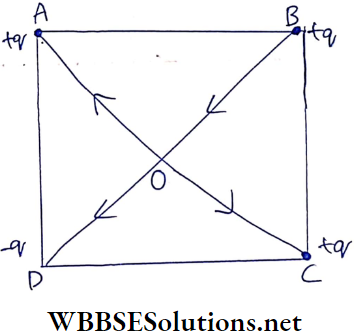
Resultant intensity at O
⇒ \(\frac{q}{(a / \sqrt{2})^2}+\frac{q}{(a / \sqrt{2})^2}=\frac{2 q}{a^2}+\frac{2 q}{a^2}=\frac{4 q}{a^2} ; \text { along } \overrightarrow{O D}\)
Question 19. On the x-y plane, two point charges +q and -q are placed at positions (0, l) and (0, -l) respectively. Find an expression for the intensity of the electric field at a point (0, y) where y >> l. Under what condition does the charging system behave as a dipole and hence express the electric field in terms of the dipole moment of the dipole so formed?
Answer:
On the x-y plane, two point charges +q and -q are placed at positions (0, l) and (0, -l) respectively.
Suppose, the electric field intensity at point C due to the charges at A and B are and E2, respectively
∴ \(E_1=\frac{1}{4 \pi \epsilon_0} \cdot \frac{q}{(y-l)^2} ; \text { along } \overrightarrow{C Y}\)
⇒ \(E_2=\frac{1}{4 \pi \epsilon_0} \cdot \frac{q}{(y+l)^2} ; \text { along } \overrightarrow{C A}\)
As E1 and E2 are acting in the opposite directions and E1 > E2, the resultant electric field at C is,
E = E1-E2
⇒ \(\frac{1}{4 \pi \epsilon_0} \cdot \frac{q}{(y-l)^2}-\frac{1}{4 \pi \epsilon_0} \cdot \frac{q}{(y+l)^2}\)
⇒ \(\frac{q}{4 \pi \epsilon_0}\left[\frac{1}{(y-l)^2}-\frac{1}{(y+l)^2}\right]=\frac{q}{4 \pi \epsilon_0} \cdot \frac{4 y l}{\left(y^2-l^2\right)^2}\)
⇒ \(\frac{1}{4 \pi \epsilon_0} \cdot \frac{4 q y l}{y^4}\) [∵ y >> 1]
⇒ \(-\frac{1}{4 \pi \epsilon_0} \cdot \frac{4 q l}{y^3} \text {; along } \overrightarrow{C Y}\)
If the value of l is small, the combination of the charges behaves as an electric dipole with dipole moment, p = q x 21.
In that case, \(E=\frac{1}{4 \pi \epsilon_0} \cdot \frac{2 p}{y^3} ; \text { along } \overrightarrow{C Y}\)
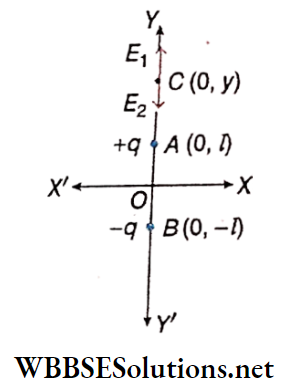
Question 20. Show graphically how the magnitude of the intensity of the electric field changes with distance r from the center of the shell.
Answer:
The variation of field intensity with distance has been shown by the curved line AB
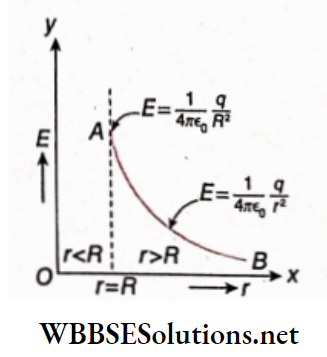
Question 21. An electric field is expressed as \(\vec{E}=20 \hat{i} \mathrm{~V} \cdot \mathrm{m}^{-1}\). Find the electric flux passing through a surface of area 0.25 m2 normal to the x-axis.
Answer:
An electric field is expressed as \(\vec{E}=20 \hat{i} \mathrm{~V} \cdot \mathrm{m}^{-1}\).
The y-z plane is perpendicular to the x-axis.
So, the given area vector is \(\vec{S}=0.25 \hat{i} \mathrm{~m}^2\)
∴ The electric flux across this area,
⇒ \(\phi=\vec{E} \cdot \vec{S}=(20 \hat{i}) \cdot 0.25 \hat{i}\)
= 5V.m
Question 22. State Gauss’s theorem in electrostatics. Find the electric flux through a surface of area 50 m2 in x-y plane in the electric field \(\vec{E}=3 \hat{i}+2 \hat{j}+\hat{k} \mathrm{~V} \cdot \mathrm{m}^{-1}\).
Answer:
The unit vector along the normal to the xy plane i.e., z axis is \(\hat{k}\).
So, the area vector = 50 \(\hat{k}\) m2
∴ Electric flux = \(\int \vec{E} \cdot \overrightarrow{d s}=\int(3 \hat{i}+2 \hat{j}+\hat{k}) \cdot \overrightarrow{d s}\)
⇒ \((3 \hat{i}+2 \hat{j}+\hat{k}) \cdot \int \vec{d} s=(3 \hat{i}+2 \hat{j}+\hat{k}) \cdot 50 \hat{k}\)
= 50 V.m
Question 23. If an electric dipole of the moment \(\vec{p}\) is placed along a uniform electric field of intensity \(\vec{E}\), the torque acting on the dipole is
- \(\vec{\tau}=\vec{p} \times \vec{E}\)
- \(\vec{\tau}=\vec{p} \cdot \vec{E}\)
- \(\vec{\tau}=\vec{p}+\vec{E}\)
- \(\vec{\tau}=0\)
The option 4 is correct.
Question 24. Define the surface density of electric charge. Two large conducting spheres carrying charges Q1 and Q2 are brought close to each other. Is the magnitude of the electrostatic force between them exactly given by \(\frac{Q_1 Q_2}{4 \pi \epsilon_0 r^2}\) where r is the distance between their centers?
Answer:
Surface charge density is the amount of electric charge per unit surface area.
Question 25. Define dielectric constant. Two charges ±20 x 10-6 C , placed 2 mm apart from an electric dipole. Determine the electric field at a point 10 cm away from the center of the dipole on its perpendicular bisector. Given,
⇒ \(\frac{1}{4 \pi \epsilon_0}=9 \times 10^9 \mathrm{~N} \cdot \mathrm{m}^2 \cdot \mathrm{C}^{-2}\)
Answer:
Dipole moment,
p = ql = (20 x 10-6) x (2 x 10-3) =4 x 10-8 C.m
10 cm >> 2 mm; So the distance of the given point is much
greater than the dipole length.
∴ \(E=\frac{1}{4 \pi \epsilon_0} \cdot \frac{p}{r^3}\)
⇒ \(\left(9 \times 10^9\right) \times \frac{\left(4 \times 10^{-8}\right)}{(0.1)^3}\) [10cm = 0.1m]
= 3.6 x 105 V.m-1
Question 26. Why are electric lines of force, not closed-loop?
Answer:
Electric lines of force start from a positive charge and end on a negative charge. There is no electric field inside a conductor, so electric field lines are not present there. Hence electric lines of force do not form a closed loop.
Question 27. A charge q is placed at the center of a cube of side l. What is the electric flux passing through each face of the cube?
Answer:
A charge q is placed at the center of a cube of side l
Flux passing through the surface of the cube = \(\frac{q}{\epsilon_0}\)
∴ Flux passing through each of the face = \(\frac{1}{6} \frac{q}{\epsilon_0}\)
Question 28. An electric dipole is held in a uniform electric field The dipole is aligned parallel to the field. Find the work done in rotating it through the angle of 180°
Answer:
An electric dipole is held in a uniform electric field The dipole is aligned parallel to the field.
Work done in rotating the dipole through an angle dθ is pEsinθdθ.
where, p = dipole moment,
E = magnitude of the field
∴ Work done in rotating the dipole from 0° (parallel to the field) to 180°
⇒ \(\int_{0^{\circ}}^{180^{\circ}} p E \sin \theta d \theta=p E[-\cos \theta]_0^{180^{\circ}}=2 p E\)
Question 29. A charge q is placed at the center of a cube. What is the electric flux passing through two opposite faces of the cube?
Answer:
A charge q is placed at the center of a cube.
The electric flux passes through two opposite faces of the cube
⇒ \(\frac{1}{6} \frac{q}{\epsilon_0} \times 2=\frac{1}{3} \frac{q}{\epsilon_0}\)
Question 30. A charge q is placed at the center of a cube. What Is the electric flux passing through the cube?
Answer:
A charge q is placed at the center of a cube.
The flux passing through the cube = \(\frac{q}{\epsilon_0}\)
Question 31. Two charges of magnitudes -2Q and +Q points (a, 0) and (4a, 0) respectively. What is the electric flux due to these charges through a sphere of radius 3a with its center at the origin?
Answer:
Two charges of magnitudes -2Q and +Q points (a, 0) and (4a, 0) respectively.
According to Gauss’ theorem,
flux through a surface,
⇒ \(\phi=\frac{\text { charge enclosed by the surface }}{\epsilon_0}\)
Since Q is outside the sphere,
flux, \(\phi=\frac{-2 Q}{\epsilon_0}\)
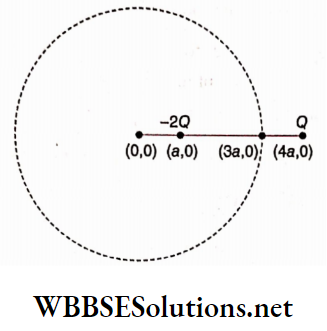
Question 32. Consider two hollow concentric spheres S1 and S2 enclosing charges 2Q and 4Q respectively.
- Find out the ratio of the electric flux through them,
- How will the electric flux through S1 change if a medium of dielectric constant er is introduced in the space inside S1 in place of air? Deduce the necessary expression.
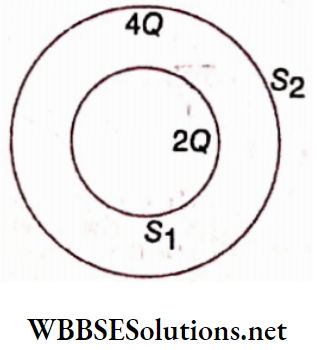
Answer:
1. According to Gausss’ theorem, flux through any surface
⇒ \(\frac{\text { charge enclosed by the surface }}{\epsilon}\)
∴ \(\frac{\phi_{s_1}}{\phi_{s_2}}=\frac{\frac{2 Q}{\epsilon}}{\frac{(2 Q+4 Q)}{\epsilon}}\)
= \(\frac{1}{3}\)
2. when the medium is filled up with a medium of dielectric constant er then, electric field,
⇒ \(E=\frac{2 Q}{4 \pi \epsilon_0 \epsilon_r r^2}\)
∴ Flux through S1
⇒ \(\int E \cdot d S=E \cdot 4 \pi r^2=\frac{2 Q}{4 \pi \epsilon_0 \epsilon_r r^2} \times 4 \pi r^2=\frac{2 Q}{\epsilon_0 \epsilon_r}\)
Question 33. A point charge +Q is placed in the vicinity of a conducting surface. Trace the field lines between the charge and the conducting surface.
Answer:
A point charge +Q is placed in the vicinity of a conducting surface.
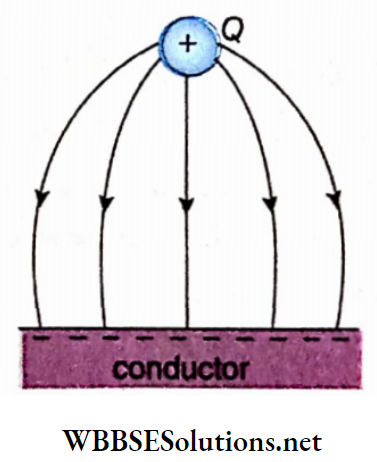
Question 34. What is the amount of work done in moving a point charge Q around a circular arc of radius ‘r’ at the center of which another point charge ‘q’ is located?
Answer:
The work done in moving a charge along any circular path is zero. So, to move a point charge Q around a circular arc of radius ‘r’ at the center of which another point charge’ is located, no work had to be done.
Question 35. Does the charge given to a metallic sphere depend on whether it is hollow or solid? Give a reason for your ambler.
Answer:
No, the charge given to a metallic sphere does not depend on whether it is hollow or solid, because all the charges given to a metallic sphere will move to the outer surface of the sphere and charges will be distributed uniformly over the surface of a sphere.
Question 36.
1. A point charge q is at a distance of directly above the center of a square of side d, as shown in the figure. Use Gauss’ law to obtain the expression for the electric flux through the square.
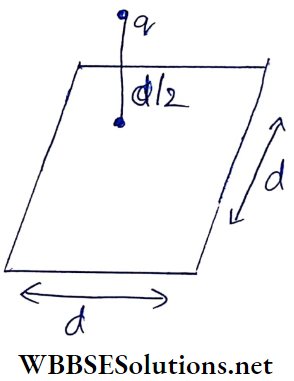
2. If the point charge is now moved to a distance d from the center of the square and the side of the square is doubled, explain how the electric flux will be affected.
Answer:
1. Let us imagine the given square is one of the faces of the cube of edge d. Where the point charge q Is at a distance of \(\frac{d}{2}\) above the center of the square. So it is enclosed by the cube. Hence by Gauss’ theorem, electric flux linked with one surface of the cube is \(Q_{\mathrm{sq}}=\frac{q}{6 \epsilon_0}\)
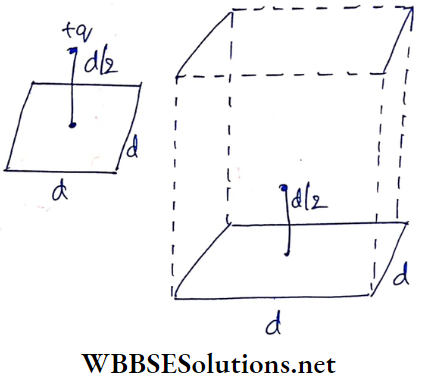
2. If the distance of the point charge from the center of the square is now doubled, the side of the square also gets doubled. So from the same symmetry, the flux through the square will still be \(\frac{q}{6 \epsilon_0}\)
Question 37. Draw a graph to show the variation of E with perpendicular distance r from the line of charge
Answer:
A graph to show the variation of E with perpendicular distance r from the line of charge
Since, \(E=\frac{\lambda}{2 \pi \epsilon_0 r} \quad\)
∴ \(E \propto \frac{1}{r}\)
Therefore, the plot of E versus r will be as shown.
